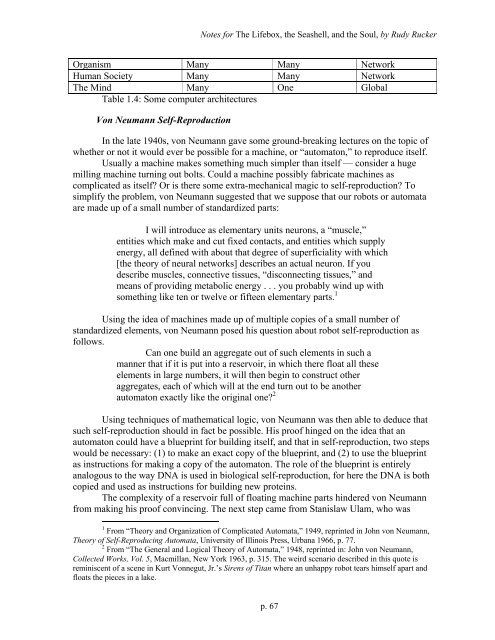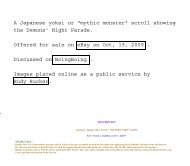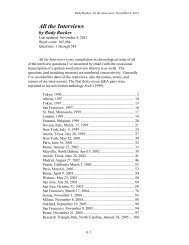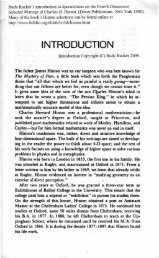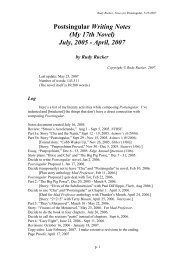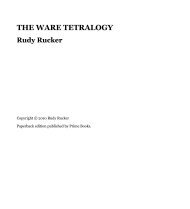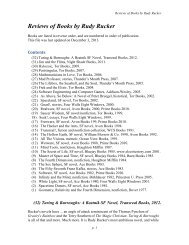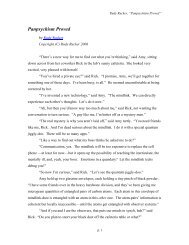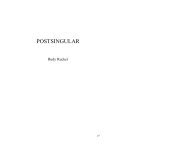Notes for the Lifebox, the Seashell, and the Soul - Rudy Rucker
Notes for the Lifebox, the Seashell, and the Soul - Rudy Rucker
Notes for the Lifebox, the Seashell, and the Soul - Rudy Rucker
You also want an ePaper? Increase the reach of your titles
YUMPU automatically turns print PDFs into web optimized ePapers that Google loves.
<strong>Notes</strong> <strong>for</strong> The <strong>Lifebox</strong>, <strong>the</strong> <strong>Seashell</strong>, <strong>and</strong> <strong>the</strong> <strong>Soul</strong>, by <strong>Rudy</strong> <strong>Rucker</strong><br />
Organism Many Many Network<br />
Human Society Many Many Network<br />
The Mind Many One Global<br />
Table 1.4: Some computer architectures<br />
Von Neumann Self-Reproduction<br />
In <strong>the</strong> late 1940s, von Neumann gave some ground-breaking lectures on <strong>the</strong> topic of<br />
whe<strong>the</strong>r or not it would ever be possible <strong>for</strong> a machine, or “automaton,” to reproduce itself.<br />
Usually a machine makes something much simpler than itself — consider a huge<br />
milling machine turning out bolts. Could a machine possibly fabricate machines as<br />
complicated as itself? Or is <strong>the</strong>re some extra-mechanical magic to self-reproduction? To<br />
simplify <strong>the</strong> problem, von Neumann suggested that we suppose that our robots or automata<br />
are made up of a small number of st<strong>and</strong>ardized parts:<br />
I will introduce as elementary units neurons, a “muscle,”<br />
entities which make <strong>and</strong> cut fixed contacts, <strong>and</strong> entities which supply<br />
energy, all defined with about that degree of superficiality with which<br />
[<strong>the</strong> <strong>the</strong>ory of neural networks] describes an actual neuron. If you<br />
describe muscles, connective tissues, “disconnecting tissues,” <strong>and</strong><br />
means of providing metabolic energy . . . you probably wind up with<br />
something like ten or twelve or fifteen elementary parts. 1<br />
Using <strong>the</strong> idea of machines made up of multiple copies of a small number of<br />
st<strong>and</strong>ardized elements, von Neumann posed his question about robot self-reproduction as<br />
follows.<br />
Can one build an aggregate out of such elements in such a<br />
manner that if it is put into a reservoir, in which <strong>the</strong>re float all <strong>the</strong>se<br />
elements in large numbers, it will <strong>the</strong>n begin to construct o<strong>the</strong>r<br />
aggregates, each of which will at <strong>the</strong> end turn out to be ano<strong>the</strong>r<br />
automaton exactly like <strong>the</strong> original one? 2<br />
Using techniques of ma<strong>the</strong>matical logic, von Neumann was <strong>the</strong>n able to deduce that<br />
such self-reproduction should in fact be possible. His proof hinged on <strong>the</strong> idea that an<br />
automaton could have a blueprint <strong>for</strong> building itself, <strong>and</strong> that in self-reproduction, two steps<br />
would be necessary: (1) to make an exact copy of <strong>the</strong> blueprint, <strong>and</strong> (2) to use <strong>the</strong> blueprint<br />
as instructions <strong>for</strong> making a copy of <strong>the</strong> automaton. The role of <strong>the</strong> blueprint is entirely<br />
analogous to <strong>the</strong> way DNA is used in biological self-reproduction, <strong>for</strong> here <strong>the</strong> DNA is both<br />
copied <strong>and</strong> used as instructions <strong>for</strong> building new proteins.<br />
The complexity of a reservoir full of floating machine parts hindered von Neumann<br />
from making his proof convincing. The next step came from Stanislaw Ulam, who was<br />
1 From “Theory <strong>and</strong> Organization of Complicated Automata,” 1949, reprinted in John von Neumann,<br />
Theory of Self-Reproducing Automata, University of Illinois Press, Urbana 1966, p. 77.<br />
2 From “The General <strong>and</strong> Logical Theory of Automata,” 1948, reprinted in: John von Neumann,<br />
Collected Works, Vol. 5, Macmillan, New York 1963, p. 315. The weird scenario described in this quote is<br />
reminiscent of a scene in Kurt Vonnegut, Jr.’s Sirens of Titan where an unhappy robot tears himself apart <strong>and</strong><br />
floats <strong>the</strong> pieces in a lake.<br />
p. 67


